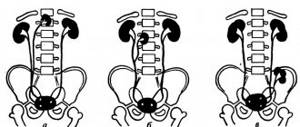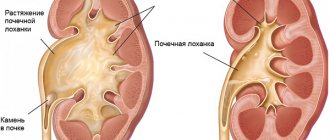Pyeelectasia is not a separate disease - its detection indicates a violation of the normal outflow of urine due to developmental abnormalities or previous infection. Pathological conditions of the pyelocaliceal system are the main etiological factor in the development of acute and chronic diseases of the urinary system.
Among children and adults, renal pyelectasis is the most common. This condition is both hereditary and acquired. Often, renal pyelectasis in men is diagnosed in adulthood, since immediately after birth this abnormality does not always manifest itself clinically.
What kind of illness is this?
The renal pelvis is a collection of calyces; it is in them that urine accumulates, and then from here it enters the ureter and is excreted from the body through it. But if, under the influence of negative factors, the outflow of urine is disrupted, and an expansion of the renal pelvis occurs in adults or children, pyelectasis is diagnosed. As the pathology progresses, not only the pelvis is affected, but also the calyx and ureter. The problem can appear in newborns and adults, but sometimes it is found during pregnancy. If the disease is not treated promptly, hydronephrosis develops, ultimately leading to renal failure.
Possible complications
If treatment for renal pyeloectasia is not started on time, stagnation of urine in the renal pelvis can provoke a number of serious consequences, including:
- pyelonephritis is an inflammatory process, the most common complication of pyelectasis;
- kidney sclerosis;
- necrosis and atrophy of renal tissue;
- renal failure;
- megaureter - lengthening and expansion of the ureter;
- ureterocele - enlargement of the ureters with a simultaneous decrease in the outlet, disrupting the process of urination;
- ureteral prolapse – its prolapse into the vagina or urethra;
- vesicoureteral reflux – the reflux of processed urine back into the kidneys;
- decreased immunity;
- intoxication;
- blood poisoning;
- death.
This diagnosis is not a death sentence. With correctly selected and timely therapy, curing pyeelectasis is not difficult. This will contribute to a full life and save a person from unpleasant consequences. Take care of your health and if you suspect the development of the described disease, go to the hospital.
Main causes
Enlargement of the renal pelvis occurs due to congenital pathologies of the development of the organs of the genitourinary system. The size of the pelvis also increases due to acquired factors, for example, the following:
- hormonal and endocrine disorders;
- infectious and inflammatory complications in the urinary system;
- injury;
- formation of tumors of various etiologies;
- formation of stones in the kidneys, bladder, ureters;
- other pathologies, with the progression of which the lumen of the urethra decreases.
Pyeelectasis in the kidneys develops due to tumors, infections, urolithiasis, injuries, hormonal or genetic disorders.
Due to these reasons, urine cannot pass normally through the affected area.
As a result, fluid is retained, and the ureter and pelvis become pathologically dilated. Such a violation can develop on the right and left, which is extremely dangerous, or one of the sides is affected. Pyeloureterectasia in newborns is a consequence of underdevelopment of the musculo-ligamentous apparatus of the genitourinary system. The disease is more often diagnosed in children born prematurely, as well as in babies with low birth weight. In infants, an enlargement of the renal pelvis is accompanied by perinatal damage to the nervous system, in which muscle tone is impaired. This provokes a violation of urine circulation, as a result of which fluid stagnates in both kidneys.
Surgery
If conservative methods do not produce results, you should consult a surgeon. If he recommends surgery, you should undergo a comprehensive diagnosis, which allows you to assess the general condition of the patient and the functionality of the entire urinary system.
The operation is mandatory if the ureter is narrowed and the pelvis is significantly enlarged.
What types are there?
Depending on the source of progression of the pathology, there are 2 forms:
- Congenital. In this case, disturbances are formed during the period of intrauterine development of the fetus, when the formation of vital organs and systems occurs.
- Acquired. The occurrence of pyeloectasia in adults is facilitated by injuries to organs located in the pelvis, inflammatory and infectious complications localized in the genitourinary system, and neoplasms of various etiologies.
Considering the location, the pathology can be:
- left-handed;
- right-sided pyelectasis;
- two-sided.
Degrees and signs
Pyeelectasis of the right and left kidneys has 3 stages of progression:
Mild degrees of renal pyeelectasis do not require therapy, while others do.
- Easy. In such a situation, there is no need to undergo a special course of treatment; it is enough to regularly visit a nephrologist and take a urine test.
- Moderate pyelectasis. In this case, adequate treatment and constant monitoring of the patient is required; ultrasound of the kidneys is regularly performed, which shows echo expansion.
- Severe degree. An enlarged pelvis does not respond to conservative treatment; the only treatment procedure that helps get rid of the pathology is surgery.
In mild or moderate progression, a person is often not bothered by signs of the disorder. More often, unilateral or bilateral pyelectasis is diagnosed accidentally, during a routine visit to the doctor. If the disease progresses, due to stagnation of urine, signs of inflammation and infection develop.
Diagnostics
In most cases, doctors are able to detect the development of the pathological process even before the birth of the child, that is, during pregnancy.
If pathological processes have already been identified, the patient should be regularly examined by a doctor. Ultrasound examination most often diagnoses moderate pyeloectasia, pyeloectasia of both kidneys and other forms of the disease. Ultrasound evaluates the condition of the renal pelvis after and before urination, changes in size over a certain period.
Urography and cystography are indicated as additional examination methods - the introduction of a contrast agent intravenously and into the urethra, respectively.
Why is pyelectasis dangerous?
If the diagnosis has confirmed that a person has an enlarged renal pelvis, it is necessary to immediately begin therapy, because the pathology does not go away on its own and causes life-threatening complications. Due to impaired urine output, organ tissues are compressed and atrophy over time. This leads to the fact that the paired organ ceases to function normally, as a result of which kidney failure develops. Pyeloectasia of the left or right kidney is often the cause of the progression of pyelonephritis, the chronic form of which also provokes kidney failure.
What treatment is prescribed for renal pyeloectasis in adults and children?
Depending on the intensity of progression of pyeloectasia of the left or right kidney, the doctor decides how to properly treat the problem. In newborns, this pathology is temporary, so special treatment is not required. It is only important to regularly see a doctor and follow all his recommendations. If in men or women pyeloetasia is accompanied by an inflammatory complication with accompanying symptoms, a course of antibacterial and anti-inflammatory therapy is prescribed.
Congenital renal pyeloectasia in children tends to go away on its own.
If the disease does not go away on its own, the person’s condition worsens, and signs of renal failure become pronounced, a decision is made to perform a surgical operation, during which the normal flow of urine is restored, if necessary, correction of congenital anomalies is carried out, stones and tumor formations are removed. The operation is often performed endoscopically, which significantly reduces the risk of developing postoperative consequences in a woman, man or child.
Diagnostic measures
To definitely establish a diagnosis, a specialist will definitely prescribe laboratory and hardware examination methods.
At the first appointment, the doctor should examine the patient’s medical history in detail. This will allow us to calculate the causes and take all necessary measures for treatment and prevention.
During examination, an experienced specialist detects the problem by palpation. Most often, pronounced swelling and puffiness is formed with severe pyelectasia or hydronephrosis.
It is especially possible to accurately determine bladder distension and kidney enlargement when the patient is thin. In people with increased body weight, this determination is complicated.
The most effective and popular way to diagnose the disease remains to this day - ultrasound.
With the help of the device, the performance of the CLS and ureters, as well as any anatomical changes, is detected.
During an ultrasound, a specialist can observe how full the bladder is, as well as what prevents urine from passing through the outflows.
With the help of ultrasound, not only the condition of the organs is revealed, but also the causes of the emerging pathology.
In addition, other hardware diagnostic methods are used, which will determine the severity of the impact on the body and the resulting complications. This:
- Endoscopic methods. Anomalies, volumetric processes, the state of the peripheral joint and the formation of stones and adhesions are determined.
- Chromocystoscopy and angiography. They allow you to observe the process of blood flow, the presence of strictures and signs of obstruction.
- Retrograde ureteropyelography.
- Exretory urography.
A number of laboratory tests will also be required:
- Blood chemistry. It is used to detect the presence of urea, creatinine and electrolyte levels.
- General urine analysis. With pyelectasia, urine contains a high concentration of hematuria, leukocytes and pyuria.
After all diagnostic measures have been completed, adequate treatment is prescribed. Much will depend on the severity of the development, the presence of complications, and the cause.
At the initial stage, no treatment may be required, but at the same time, the person should regularly visit a doctor and undergo examinations.
Therapy with folk remedies
Traditional recipes can be used as an auxiliary therapy, but abandoning traditional methods of treatment is unsafe for life. In case of an inflammatory complication, it is recommended to drink as much fluid as possible for a speedy recovery. You can prepare a vitamin infusion:
- pour a handful of rose hips into a thermos and pour 2 liters of boiling water;
- leave for 2-2.5 hours, add a spoonful of honey before use;
- drink every day until the condition returns to normal.
Prevention
Timely treatment of diseases and a healthy lifestyle reduce the risk of developing renal pyelectasis.
It is impossible to prevent the development of congenital pyeloectasia, but acquired pathology can be prevented. If a person has already had such a disease, then from now on it is important to be attentive to health, promptly treat inflammatory and infectious diseases, and not refuse to undergo routine medical examinations. It is also worth protecting the kidneys from hypothermia; with a sedentary lifestyle, when there is a risk of developing stagnant processes in the organ, it is recommended to perform warm-up physical exercises during the day as a preventive measure. If the problem begins to develop during pregnancy, the woman needs to undergo regular tests and monitor the condition.










